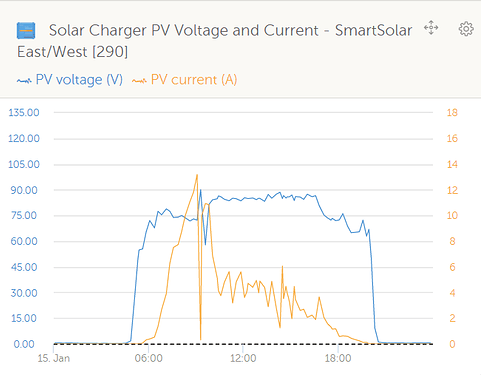I often hear people talk about that it is more efficient to run an mppt closer to the top end of it’s voltage range, any merit to that
Whatever efficiency gains there are, it’s going to be too small to really bother with. You push the voltage up to get the current down so you can use less/thinner cabling 
I have to agree with plonkster. On the electronics side there are some tolerances, but these will be small and they are designed to work within those tolerances and voltages.
I think the only place where you might see some gain is where you need to breach your battery voltage by a margin before the MPPT can start the use the PV to charge your battery.
For example if you have a battery running at 50V (48V) your MPPT can only start charging it when the PV reach around 60V.
Again this will be very small because as soon as your PV get sun it jumps to it’s design voltage. The current is a ramp up, but not the voltage.
You can see this if you look at the PV Voltage and Current graph.
I have a little experience in this. For years I used to connect my 330w panels in 2S (roughly 90v) as per the recommendation of other forum members (not this forum). My MPPT can handle up to 150VDC, but I was advised by members not to get too close to that voltage. Then I attended a training session at Microcare and the technician there said to rather try connect my panels in 3S (roughly 135v). Well I did that and saw an immediate difference during cloudy and rainy days. If there was light rain using my 2S configuration there was literally 0w charging. Now during light rain with the 3S configuration there is at least a 300w to 600w charge from my 5940w array.
Keep in mind that this is ONLY noticed when very cloudy or raining lightly. If there is a heavy downpour the charge goes to 0w.
Also keep in mind that you should always follow the manufacturer’s specs and not listen to anecdotal evidence.
As I understand it, you should look at the maximum open circuit voltage of your PV modules at the lowest temperature you expect in your area. For example, the 315W modules on my roof remain under 50V as long as the temperature is above -7°C, which means I can go 3-series on a 150V controller in my area (where there is only one recorded day with a temperature that low, and that was 50 years ago). But I would not advise someone in Harrismith to do the same thing.
